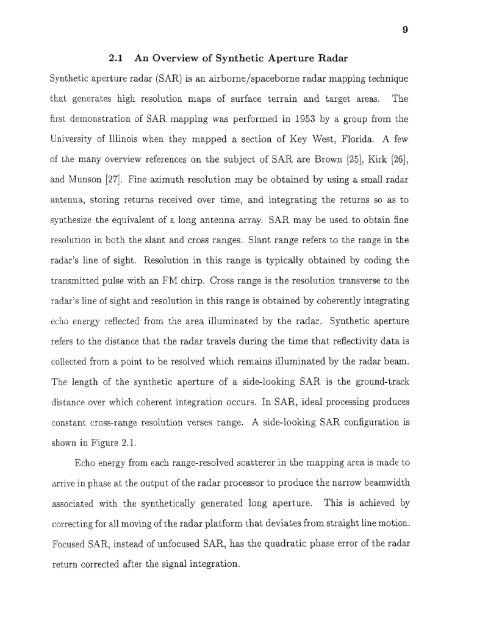Space/time/frequency methods in adaptive radar - New Jersey ...
Space/time/frequency methods in adaptive radar - New Jersey ...
Space/time/frequency methods in adaptive radar - New Jersey ...
You also want an ePaper? Increase the reach of your titles
YUMPU automatically turns print PDFs into web optimized ePapers that Google loves.
92.1 An Overview of Synthetic Aperture RadarSynthetic aperture <strong>radar</strong> (SAR) is an airborne/spaceborne <strong>radar</strong> mapp<strong>in</strong>g techniquethat generates high resolution maps of surface terra<strong>in</strong> and target areas. Thefirst demonstration of SAR mapp<strong>in</strong>g was performed <strong>in</strong> 1953 by a group from theUniversity of Ill<strong>in</strong>ois when they mapped a section of Key West, Florida. A fewof the many overview references on the subject of SAR are Brown [25], Kirk [26],and Munson [27]. F<strong>in</strong>e azimuth resolution may be obta<strong>in</strong>ed by us<strong>in</strong>g a small <strong>radar</strong>antenna, stor<strong>in</strong>g returns received over <strong>time</strong>, and <strong>in</strong>tegrat<strong>in</strong>g the returns so as tosynthesize the equivalent of a long antenna array. SAR may be used to obta<strong>in</strong> f<strong>in</strong>eresolution <strong>in</strong> both the slant and cross ranges. Slant range refers to the range <strong>in</strong> the<strong>radar</strong>'s l<strong>in</strong>e of sight. Resolution <strong>in</strong> this range is typically obta<strong>in</strong>ed by cod<strong>in</strong>g thetransmitted pulse with an FM chirp. Cross range is the resolution transverse to the<strong>radar</strong>'s l<strong>in</strong>e of sight and resolution <strong>in</strong> this range is obta<strong>in</strong>ed by coherently <strong>in</strong>tegrat<strong>in</strong>gecho energy reflected from the area illum<strong>in</strong>ated by the <strong>radar</strong>. Synthetic aperturerefers to the distance that the <strong>radar</strong> travels dur<strong>in</strong>g the <strong>time</strong> that reflectivity data iscollected from a po<strong>in</strong>t to be resolved which rema<strong>in</strong>s illum<strong>in</strong>ated by the <strong>radar</strong> beam.The length of the synthetic aperture of a side-look<strong>in</strong>g SAR is the ground-trackdistance over which coherent <strong>in</strong>tegration occurs. In SAR, ideal process<strong>in</strong>g producesconstant cross-range resolution verses range. A side-look<strong>in</strong>g SAR configuration isshown <strong>in</strong> Figure 2.1.Echo energy from each range-resolved scatterer <strong>in</strong> the mapp<strong>in</strong>g area is made toarrive <strong>in</strong> phase at the output of the <strong>radar</strong> processor to produce the narrow beamwidthassociated with the synthetically generated long aperture. This is achieved bycorrect<strong>in</strong>g for all mov<strong>in</strong>g of the <strong>radar</strong> platform that deviates from straight l<strong>in</strong>e motion.Focused SAR, <strong>in</strong>stead of unfocused SAR, has the quadratic phase error of the <strong>radar</strong>return corrected after the signal <strong>in</strong>tegration.
















